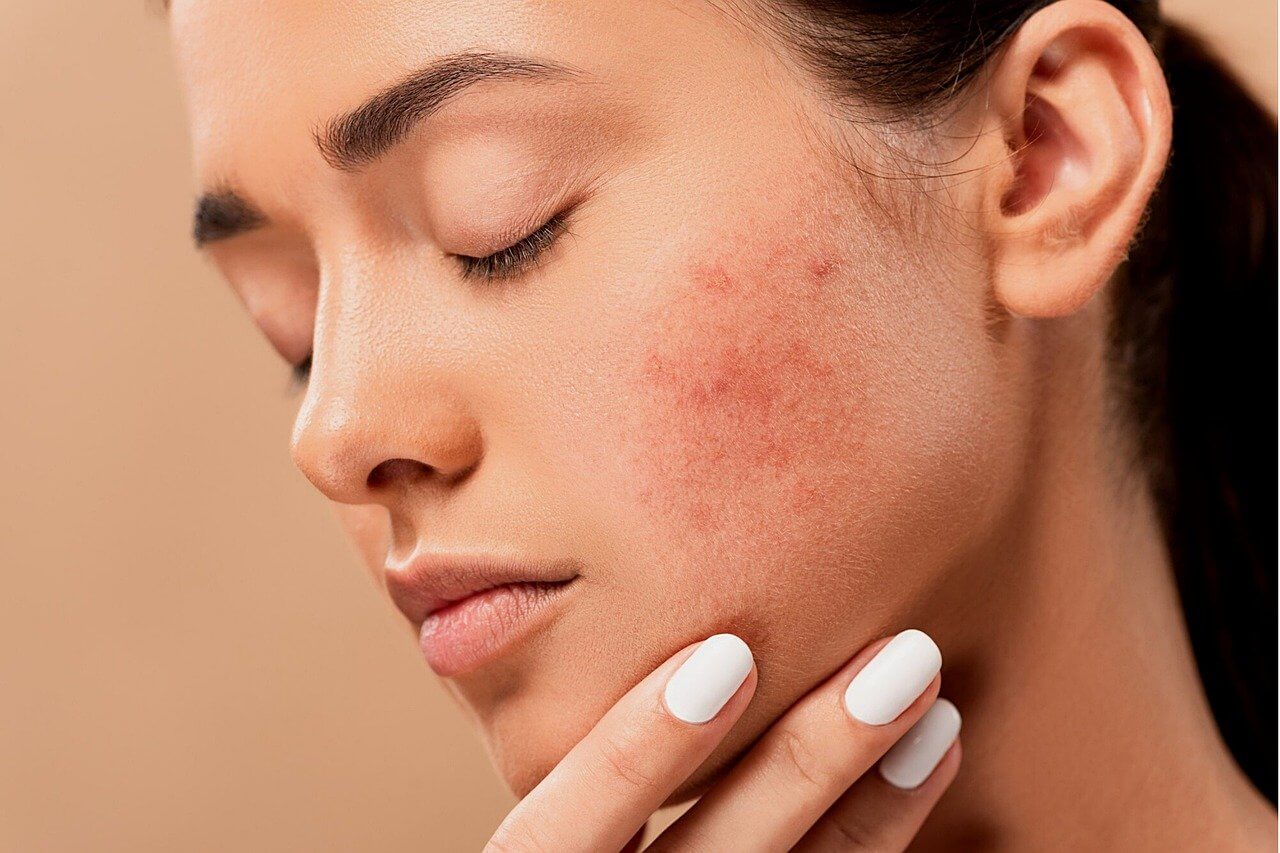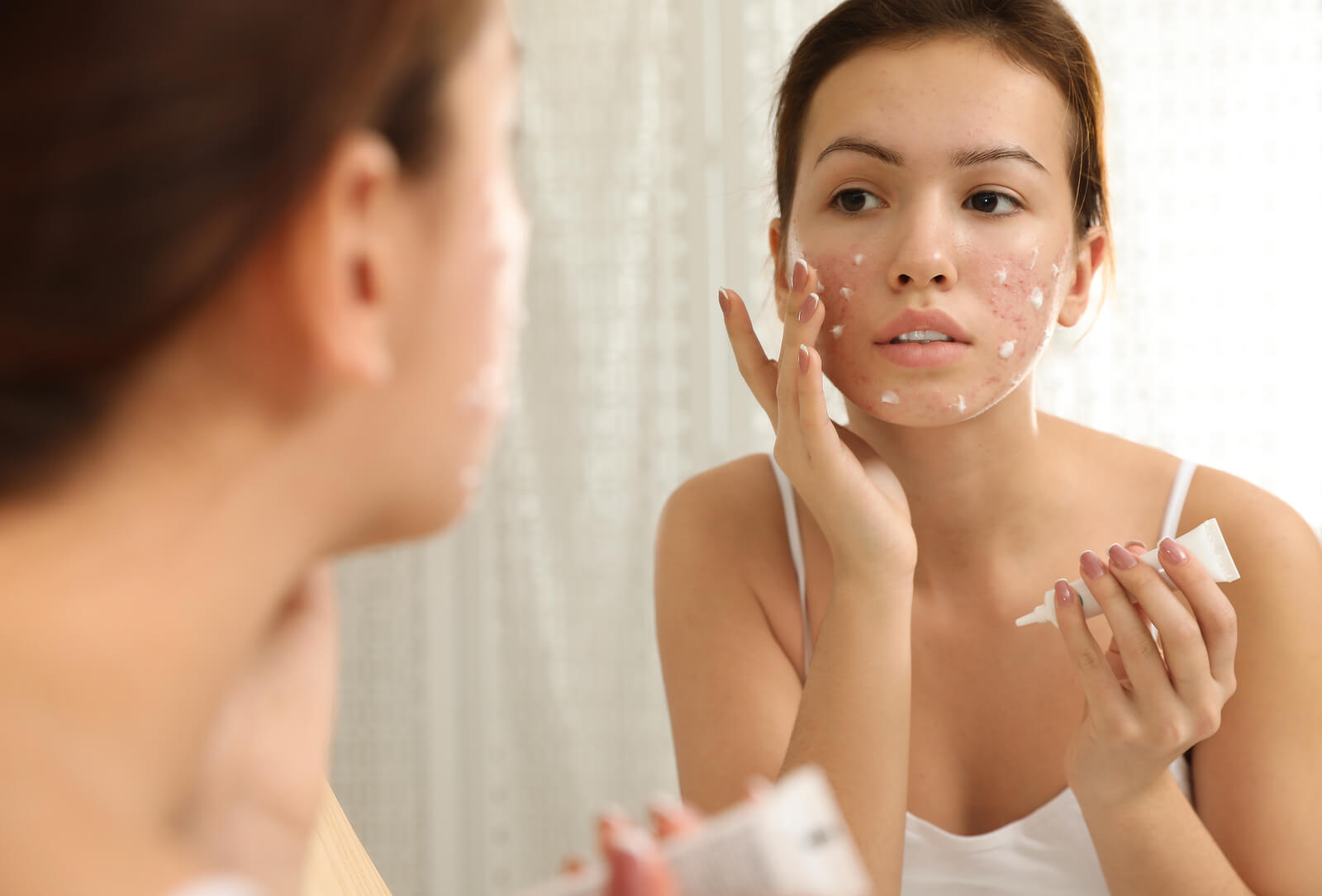Premenstrual Acne: How the Menstrual Cycle Affects Acne

Premenstrual acne is a common discomfort among women, even after they’re 25 or 30 years old. It usually appears a few days before menstruation, and not only in oily or acne-prone skin, but in skin of all kinds.
According to recent studies, premenstrual acne affects a significant number of menstruating women. The majority (more than 50%) affirm that the symptoms are worse the week before menstruation.
In an investigation published in the Journal of the American Academy of Dermatology, it was observed that in a sample of 400 women aged between 12 and 52 years of age, women older than 33 years had a higher rate of premenstrual outbreaks in relation to women between 20 and 33 years old.
Due to the data obtained in studies like the one already mentioned, there are researchers who have even estimated that the incidence of premenstrual acne is between 50 and 80%. Let’s see more about it below.
Symptoms of premenstrual acne

The symptoms of premenstrual acne are usually quite specific:
- Swollen pores.
- Increased production of oil/fat in the skin.
- Breakout of spots (in the area of the cheeks, chin, and neck, although it can also affect the forehead)
Depending on the skin type and if the woman has had (or not) acne since adolescence, the breakouts could vary in their intensity and annoyance.
Causes of premenstrual acne
Even after having left adolescence behind, many women notice that their skin tends to become more oily and prone to pimple breakouts before their period. This is aside from the fact of whether they have persistent acne from their early teens or not.
Thanks to the scientific literature, it has become clear that acne is a multifactorial condition. Neither chocolate binges nor stress peaks are capable – by themselves – of triggering an acne breakout, although they can aggravate it.
Premenstrual acne occurs as a consequence of the interaction of several factors, among which hormonal activity seems to predominate – mainly the activity of progesterone.
The release of an egg from the ovary each month (ovulation) appears to trigger symptoms. After ovulation, the hormone progesterone passes into the bloodstream from the ovaries and women with PMS are thought to be more sensitive to normal levels of progesterone, states the fact sheet prepared by the experts at Women’s Health Concern.
Treatment

It’s highly recommended that you go to the dermatologist both for a check-up and to resolve all doubts regarding your skincare routine, including ways to prevent and treat breakouts with over-the-counter products, etc. This will allow you to deal with PMS in the most appropriate way and will minimize the risk of worsening breakouts.
Some important recommendations to keep in mind are the following:
- Cleanse your skin with the right products. Don’t apply the same soap that you use for the rest of the body.
- Keep your skin hydrated by applying a non-comedogenic lotion or cream daily.
- Protect yourself from the sun with a non-comedogenic sunscreen.
- If you’re going to wear makeup, it should be non-comedogenic and oil-free. And you should always remove it with a suitable remover before going to sleep.
- Avoid touching your face and handling pimples and spots. It’s far better for you to go to the beauty center recommended by your dermatologist for a good cleaning.
- Consult with your dermatologist as to what should be the most appropriate frequency to carrying out exfoliation. Keep in mind that if you exfoliate on a daily basis you could excessively mistreat your skin and make it more prone to any problems, in addition to acne.
Depending on what the specialist observes in their examination, he or she could prescribe a topical medication or refer you to the family doctor or gynecologist to assess the use of contraceptive pills, in order to treat acne.
Remember that not all women respond well to birth control pills, retinoids, or other treatments. For this reason, it’s important to have a specialist’s assessment before taking any action.
Remember that, although it’s important to follow the recommendations of the specialist, you shouldn’t neglect keeping good lifestyle habits.
Eating in a balanced way, drinking plenty of water daily, exercising regularly, and getting plenty of rest are also measures that contribute greatly to skin health and help keep premenstrual acne at bay.
Premenstrual acne is a common discomfort among women, even after they’re 25 or 30 years old. It usually appears a few days before menstruation, and not only in oily or acne-prone skin, but in skin of all kinds.
According to recent studies, premenstrual acne affects a significant number of menstruating women. The majority (more than 50%) affirm that the symptoms are worse the week before menstruation.
In an investigation published in the Journal of the American Academy of Dermatology, it was observed that in a sample of 400 women aged between 12 and 52 years of age, women older than 33 years had a higher rate of premenstrual outbreaks in relation to women between 20 and 33 years old.
Due to the data obtained in studies like the one already mentioned, there are researchers who have even estimated that the incidence of premenstrual acne is between 50 and 80%. Let’s see more about it below.
Symptoms of premenstrual acne

The symptoms of premenstrual acne are usually quite specific:
- Swollen pores.
- Increased production of oil/fat in the skin.
- Breakout of spots (in the area of the cheeks, chin, and neck, although it can also affect the forehead)
Depending on the skin type and if the woman has had (or not) acne since adolescence, the breakouts could vary in their intensity and annoyance.
Causes of premenstrual acne
Even after having left adolescence behind, many women notice that their skin tends to become more oily and prone to pimple breakouts before their period. This is aside from the fact of whether they have persistent acne from their early teens or not.
Thanks to the scientific literature, it has become clear that acne is a multifactorial condition. Neither chocolate binges nor stress peaks are capable – by themselves – of triggering an acne breakout, although they can aggravate it.
Premenstrual acne occurs as a consequence of the interaction of several factors, among which hormonal activity seems to predominate – mainly the activity of progesterone.
The release of an egg from the ovary each month (ovulation) appears to trigger symptoms. After ovulation, the hormone progesterone passes into the bloodstream from the ovaries and women with PMS are thought to be more sensitive to normal levels of progesterone, states the fact sheet prepared by the experts at Women’s Health Concern.
Treatment

It’s highly recommended that you go to the dermatologist both for a check-up and to resolve all doubts regarding your skincare routine, including ways to prevent and treat breakouts with over-the-counter products, etc. This will allow you to deal with PMS in the most appropriate way and will minimize the risk of worsening breakouts.
Some important recommendations to keep in mind are the following:
- Cleanse your skin with the right products. Don’t apply the same soap that you use for the rest of the body.
- Keep your skin hydrated by applying a non-comedogenic lotion or cream daily.
- Protect yourself from the sun with a non-comedogenic sunscreen.
- If you’re going to wear makeup, it should be non-comedogenic and oil-free. And you should always remove it with a suitable remover before going to sleep.
- Avoid touching your face and handling pimples and spots. It’s far better for you to go to the beauty center recommended by your dermatologist for a good cleaning.
- Consult with your dermatologist as to what should be the most appropriate frequency to carrying out exfoliation. Keep in mind that if you exfoliate on a daily basis you could excessively mistreat your skin and make it more prone to any problems, in addition to acne.
Depending on what the specialist observes in their examination, he or she could prescribe a topical medication or refer you to the family doctor or gynecologist to assess the use of contraceptive pills, in order to treat acne.
Remember that not all women respond well to birth control pills, retinoids, or other treatments. For this reason, it’s important to have a specialist’s assessment before taking any action.
Remember that, although it’s important to follow the recommendations of the specialist, you shouldn’t neglect keeping good lifestyle habits.
Eating in a balanced way, drinking plenty of water daily, exercising regularly, and getting plenty of rest are also measures that contribute greatly to skin health and help keep premenstrual acne at bay.
- Geller L, Rosen J, Frankel A, Goldenberg G. Perimenstrual flare of adult acne. J Clin Aesthet Dermatol. 2014 Aug;7(8):30-4. PMID: 25161758; PMCID: PMC4142818.
- Itsekson A, Lazarov A, Cordoba M, Zeitune M, Abraham D, Seidman DS. Premenstrual syndrome and associated skin diseases related to hypersensitivity to female sex hormones. J Reprod Med. 2004 Mar;49(3):195-9. PMID: 15098889.
-
Rivera, R., and A. Guerra. 2009. “Manejo Del Acné En Mujeres Mayores de 25 Años.” Actas Dermo-Sifiliográficas 100 (1): 33–37. https://doi.org/10.1016/s0001-7310(09)70054-7.
-
Torras Enríquez, Helena. 2006. “Acne in the Adult Woman.” Piel 21 (7): 343–48. https://doi.org/10.1016/S0213-9251(06)72505-9.
-
Varios. 2019. “Tratamiento Del Acné.” Boletín Terapéutico Andaluz 34 (4): 38–48.
Este texto se ofrece únicamente con propósitos informativos y no reemplaza la consulta con un profesional. Ante dudas, consulta a tu especialista.







